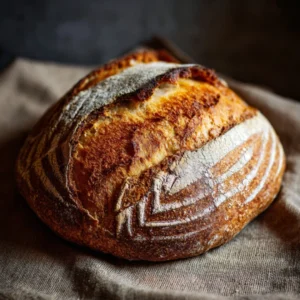Baking sourdough bread at home can feel like a magical experience. From mixing the starter and flour to the final golden crust, this process brings a sense of accomplishment and delight. Sourdough bread is not just bread; it’s a journey that rewards patience and care with a chewy, flavorful loaf that fills your home with an irresistible aroma. This guide will take you step by step through making your very own sourdough bread, even if you are just starting out.
Why We Love This Sourdough Bread Recipe
This sourdough bread recipe is perfect for beginners because it combines simplicity with traditional techniques. You don’t need fancy equipment or advanced baking skills to create a beautiful loaf. The flavor is naturally complex, with a slight tang that comes from a well-fed starter. The crust is crisp and golden, while the inside is soft, airy, and chewy. It’s versatile too—you can enjoy it fresh with butter, toast it for breakfast, or use it to make sandwiches. Learning to bake sourdough gives you the confidence to experiment with different flours and techniques, making each loaf uniquely yours.
Ingredients for Sourdough Bread
Making sourdough bread starts with the right balance of ingredients. You only need a few essentials, but the quality and measurements are important to ensure a perfect loaf every time.
- 310 grams warm filtered water (about 1 1/3 cups) at 90°F
- 120 grams active sourdough starter (1/2 cup)
- 500 grams bread flour (roughly 4 cups plus 2 tablespoons)
- 16 grams fine sea salt (2 teaspoons)
How to Make Sourdough Bread
The process of making sourdough bread involves multiple steps, each contributing to the final texture and flavor. First, you mix the starter with warm water to activate the yeast and prepare the dough for kneading. Adding flour and salt gives structure and flavor, while a short resting period allows the gluten to begin forming naturally.
Next comes the stretch and fold method. By wetting your hands and gently stretching sections of dough over the center, you strengthen the gluten without heavy kneading. This step is repeated several times, letting the dough rest in between. The bulk rise follows, where the dough rests for 6 to 12 hours until it becomes puffy and airy. Testing the dough with a simple finger poke ensures it’s ready for shaping.
Shaping is an art in itself. You lift and pinch the dough into a smooth ball, ensuring even tension across the surface. A floured kitchen towel helps prevent sticking, and letting the dough rest for a short period improves final texture. For a deeper flavor, you can refrigerate the dough for up to 36 hours before baking.
Baking sourdough requires a hot oven and a covered pot to mimic a professional steam oven. Preheating your Dutch oven ensures the bread bakes evenly and develops a crisp, golden crust. Scoring the top allows controlled expansion while baking. After removing the lid partway through, the bread finishes baking to a rich brown, with a crunchy exterior and soft, chewy interior. Cooling completely before slicing is essential to avoid a gummy texture.
How to Serve Sourdough Bread
Sourdough bread is incredibly versatile when it comes to serving. Freshly baked, it pairs beautifully with butter, olive oil, or your favorite spread. Toast slices in the morning for a hearty breakfast or make open-faced sandwiches with fresh vegetables, cheese, or deli options. Sourdough also works well alongside soups and stews, adding texture and flavor to your meal. You can even use slightly stale sourdough to make croutons or breadcrumbs, reducing waste and maximizing its use in your kitchen.
Serving sourdough bread doesn’t need to be complicated. Simply slice, plate, and enjoy. Its robust flavor stands up to both simple and sophisticated pairings, making it a staple in your home.
Expert Tips for Sourdough Bread
To make the best sourdough bread, consistency is key. Always feed your starter regularly and ensure it is active before baking. The temperature of your kitchen and water affects fermentation, so aim for room temperatures around 68°F to 75°F for optimal results. Stretch and fold gently to preserve the air pockets in the dough while strengthening gluten.
When shaping, handle the dough carefully to maintain its structure. Dusting with flour or rice flour prevents sticking and enhances the appearance of your loaf. During baking, use a covered pot to trap steam, which helps form a crisp crust. Lastly, allow the bread to cool completely before slicing to develop its full flavor and texture.
How to Store Sourdough Bread
Proper storage keeps your sourdough fresh longer. Keep the bread at room temperature in a paper bag or wrapped in a clean kitchen towel. Avoid plastic bags, as they trap moisture and can make the crust soft. Sourdough can also be sliced and frozen for later use. Simply thaw at room temperature or toast slices directly from the freezer for convenience.
Variations of Sourdough Bread
Sourdough bread is incredibly adaptable. You can mix in whole wheat or rye flour to introduce different flavors and textures. Adding seeds such as sunflower, sesame, or flax can enhance both taste and nutrition. For a sweeter twist, try incorporating dried fruits like raisins or cranberries. Adjusting hydration levels slightly can also yield a more open crumb or denser loaf, depending on your preference. Each variation allows you to customize the bread while still preserving the classic sourdough characteristics.
Frequently Asked Questions About Sourdough Bread
How long does sourdough bread last?
Sourdough bread lasts about 3 to 5 days at room temperature when stored properly. Freezing extends its shelf life to several months.
Do I need a sourdough starter to make this bread?
Yes, a healthy, active sourdough starter is essential for the natural fermentation and flavor of the bread.
Can I use whole wheat flour instead of bread flour?
Absolutely. Whole wheat flour can be used, though the texture will be denser. You can mix it with bread flour for a lighter loaf.
Why is my sourdough bread dense?
Dense bread usually indicates under-proofing, low hydration, or an inactive starter. Ensure the dough rises properly and your starter is bubbly and active before baking.
Can I bake sourdough without a Dutch oven?
Yes, you can bake on a baking sheet with a pan of water in the oven to create steam. However, a covered pot produces the best crust.

Sourdough Bread
Equipment
- Dutch Oven
- Mixing Bowls:
- Kitchen scale
Ingredients
- 310 grams warm filtered water about 1 1/3 cups at 90°F
- 120 grams active sourdough starter about 1/2 cup
- 500 grams bread flour roughly 4 cups plus 2 tablespoons
- 16 grams fine sea salt about 2 teaspoons
Instructions
- In a large mixing bowl, mix warm water and active sourdough starter until well combined.
- Add the bread flour and sea salt to the mixture, stirring until a shaggy dough forms.
- Let the dough rest for 30 minutes to allow the gluten to develop.
- Perform a series of stretch and folds every 30 minutes for the next 2-3 hours, letting the dough rest in between.
- After bulk fermentation (6-12 hours), shape the dough into a ball and place it seam-side down in a floured bowl or on a floured surface.
- Let the dough rest for 30 minutes, then refrigerate for up to 36 hours for enhanced flavor.
- Preheat your oven to 450°F (232°C) with your Dutch oven inside.
- Carefully transfer the dough to the hot Dutch oven, score the top, and cover with the lid.
- Bake for 30 minutes covered, then remove the lid and bake for an additional 15-20 minutes until golden brown.
- Let the bread cool completely on a wire rack before slicing.
Send me this recipe!
Just enter your email below and get it sent straight to your inbox!



